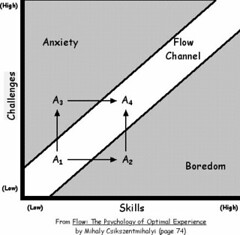 Image via CrunchBase Forbes
Image via CrunchBase ForbesJames Slavet, Greylock Partners
This is a guest post from James Slavet of venture firm Greylock Partners. Slavet’s investments include Coupons.com, Groupon, One Kings Lane and Redfin. Greylock Partners has invested in Facebook, LinkedIn and Pandora..
…“If you can measure it, you can manage it” is a business saying that goes way back. … Regardless, most managers only measure outputs, not inputs… Similarly, most companies measure traffic, revenue or earnings, without considering how to improve the company at an atomic level: how to make a meeting better, or an engineer more productive.
Here are five metrics that great teams should measure:
![Flow [psychology]](http://farm3.static.flickr.com/2603/4118479012_abda6f02d0_m.jpg) Image by Jordanhill School D&T Dept via FlickrMetric 1: Flow State Percentage
Image by Jordanhill School D&T Dept via FlickrMetric 1: Flow State PercentageIdeally … knowledge workers can spend 30% – 50% of their day in uninterrupted concentration. Most office environments don’t even come close. To get started, ask your engineers to track for a few days their personal flow state percentages: how many hours each day are they in flow, divided by the number of total hours they’re at the office. And then brainstorm ways that the team can move this number up. … Tom Demarco has written insightfully on the topic of flow.
 Image by Wesley Fryer via FlickrMetric 2: The Anxiety-Boredom Continuum
Image by Wesley Fryer via FlickrMetric 2: The Anxiety-Boredom Continuum… Star performers can get bored easily, and often function best when they’re expected to rise to great challenges. You want expectations to be high, but not completely overwhelming. With this in mind, check in with your employees periodically … If they have low energy, or are showing up late and leaving early, they may be bored. If they’re responding to small setbacks with anger or frustration, or getting sick a lot, they may be pushing too hard.
Metric 3: Meeting Promoter Score
…[A] one-hour meeting of six software engineers costs $1,000 at least. …Nobody tracks whether meetings are useful, or how they could get better. And all you have to do is ask.
In the last minute of a meeting, ask the participants to each rate from 1 to 10 how effective the meeting was, with one suggestion for making the meeting better. … Verne Harnish has some good ideas about running better meetings.
Metric 4: Compound Weekly Learning Rate
… Joi Ito wrote recently about “neotony”, the retention of childlike attributes in adulthood. This ability to learn is like the compounding interest on an investment: after two or three years, a relentless learner stands head and shoulders above his peers. … So try asking your team this question: how did you get 1% better this week? Did you learn something valuable from our customers, or make a change to our product that drove better results? As your team gets into a learning rhythm, you can review this as a group. 1% per week adds up.
 Image via WikipediaMetric 5: Positive Feedback Ratio
Image via WikipediaMetric 5: Positive Feedback Ratio
…John Gottman …, a psychologist, is the author of “Why Marriages Succeed or Fail”.
In his research, he found that marriages that succeed tend to have five times as many positive interactions as negative ones. And when a couple falls below that ratio, their relationship falls down too.
 Cover via AmazonThe same is true at the office, … Catch people doing good things. Never miss a chance to say something nice, even if you feel a little silly. Then when you have feedback on areas to improve, they‘ll really listen. It may be hard to manage to the 5:1 ratio at the office, but you should be mindful of the balance.
Cover via AmazonThe same is true at the office, … Catch people doing good things. Never miss a chance to say something nice, even if you feel a little silly. Then when you have feedback on areas to improve, they‘ll really listen. It may be hard to manage to the 5:1 ratio at the office, but you should be mindful of the balance.So, there you have it, 5 metrics that will never show up in the best companies’ financial statements or a Wall Street Journal article, but are the kinds of reasons those companies succeed. Tracking these five metrics isn’t glamorous. But it’s something everyone can do. And it really works.








No comments:
Post a Comment